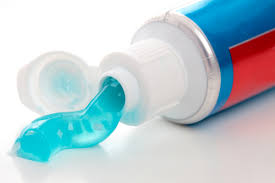Throughout history humans have struggled to implement effective dental care to protect their teeth. Ash, cloth, twigs, feathers and other foreign objects have all been used to help promote dental health during the evolution of dentistry, but when mass produced toothpaste first made it onto the scene, everything changed.
Ever since Crest became available for purchase in 1955, the oral hygiene industry has grown to have annually revenues exceeding the $2 billion dollar mark. Now American store shelves are filled to the brim with close to 350 types of toothpastes. Every toothpaste is different, some are marketed to target a specific dental problem white others are flavored to appeal to children. Despite the proclaimed differences (in color, flavor and texture) of the products, behind the scenes a majority of toothpastes contain similar ingredients.
Brushing with toothpaste helps remove the bacteria that cause dental plaque and bad breath. Most of toothpastes also have ingredients (such as fluoride or xynitol) that are know cavity fighters. Aside from those elements, there are other compounds in the products that help give toothpaste specific characteristics that consumers expect from the brushing specific product.
Cocamidopropyl Betaine
Dentists and dental health experts advise consumers to only use a dime sized portion of toothpaste when cleaning teeth. That is because they know that the repetitive motion of brushing will cause toothpaste to foam and expand. Cocamidopropyl betaine is the ingredient that causes the froth not only in toothpaste but other consumer products including shampoo and soap.
Cocamodopropyl betain is formulated from coconut oil and dimethylaminopropylamine. The compound itself is pale yellow liquid. When the toothpaste is sitting in the tube, the cocamidopropyl betain helps preserve the flavor; when activated by brushing foam will be produced and allow the toothpaste to spread throughout the mouth in order to help remove stray refuse floating about.
Glycerin
Glycerin is a transparent, colorless, odorless, viscous liquid known for its moisturizing abilities. The compound is a favorite of food stylists (it is used to make fruit and food look luscious, fresh and shiny in photo and film shoots) and a necessity of parents with constipated children (it is a known laxative). It is also in many toothpastes.
The simple polyol compound is added to toothpaste to extend the shelf life of toothpaste as the additive will prevent it from drying out. Glycerin will also enhance toothpaste flavor and help moisturize a mouth to help ease dry mouth.
Glycerin can be derived from both animal and vegetable sources. Vegetarians and vegans need to be especially cautious choosing the right toothpaste in order to ensure it meets with their dietary regulation.
Calcium Carbonate
All toothpastes need some type of abrasive agent in order to help aid in the tooth-cleaning abilities. There are a variety of options including mica or hydrated silica. Another option is calcium carbonate, the main compound in shells (including marine organisms, snails and eggs).
Calcium carbonate is often used in the medical industry as an inexpensive dietary supplement for calcium (essential for bone and tooth health). However, the main role of the ingredient in toothpaste is to provide a little friction to help remove excess dental plaque and food particles stuck in a mouth.
Not all ingredients appear in every toothpaste, allowing individuals to have plenty of purchasing options. Individuals needing further tips for toothpaste selection will be able to get the best advice from their dentist.

